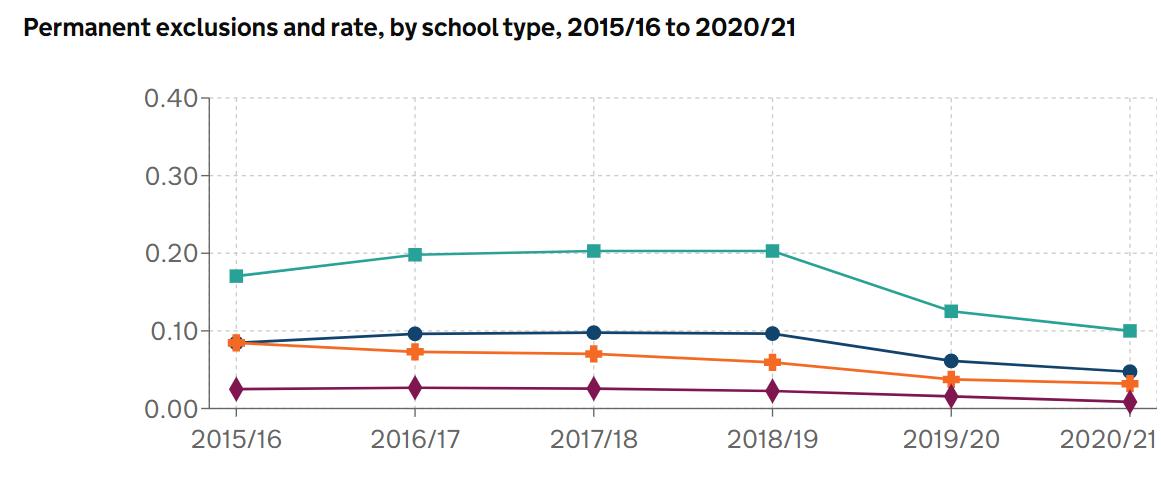




It’s half-way through November which means, I think, that we are now officially allowed to talk about the C-word… Christmas! The Halloween decorations have been firmly put away, Mariah Carey is defrosting as we speak, and the countdown is on. It may seem early - and I’m sure there are plenty of Grinches who think it is way too soon to start thinking about the festive season - but after another challenging year I think we could all do with some festive cheer. Also, this is the first Christmas since 2019 that promises not to marred by COVID restrictions, so that is something to look forward to if nothing else!
Our November issue is jam-packed full of expert advice covering topics from leadership, progression and wellbeing to marketing, ICT and compliance. To kick off our LEADERSHIP BY EXAMPLE section, Lorraine Langham explains how children who are lacking positive role models can access inspiration in your school, and Stephen Mitchell offers his advice on how you can convert your school’s values and visions into everyday operations.
SBL wellbeing and resilience has never been more pertinent than now, when pressures are rising and resources are dwindling. Dedicated to the memory of Julie Cordiner, Val Andrew explains how you can use the 3 Ps to get through these difficult times and, echoing the wise words of McFly, Phil Burton says ‘It’s all about you’ as he explores how you can manage your wellbeing during the school day. David Carne tells us all about the power of ‘positive psychology’ and Emma Gray discusses her own experiences to highlight why it is so important that we know the right ways to support those who are struggling.
Moving away into operations, Helen Burge channels her inner ‘Green Cross Code man’ to help you develop an effective travel plan for your school, and Simon Hepburn gives his top tips on how to create an additional revenue stream through school lettings. Turning to our ICT experts, Gary Henderson and Nigel Milligan discuss becoming more sustainable in your school’s tech use and which devices are most effective in schools.
As always, we’d love to hear any suggestions you have for the magazine. If you’d like to get involved with EdExec, or if you’d like us to cover a certain topic, please do let us know. Contact eleanor@intelligentmedia.co.uk or tweet @edexec with ideas, opinions or success stories.
Is your school doing something wonderful? Do you have an opinion or experience you’d like to share? A story suggestion? Or some advice you’d like to share with your peers?
Get in touch – email eleanor@ intelligentmedia.co.uk
The education sector can be difficult to navigate at times, and those in school business management play a pivotal role in steering schools to success. Tasked with everything from finance and procurement, to HR and admin, you keep the education cogs turning. Education Executive addresses the most pressing matters faced by SBMs, offering meaningful insights and practical advice.
ELEANOR POTTER Editor Education Executive
LORRAINE LANGHAM CEO Future First
STEPHEN MITCHELL Owner KeystoneKnowledge
VAL ANDREW Programme manager Best Practice Network DSBM Level 4
PHIL BURTON Business manager HallbrookandCosbyPrimarySchool
HELEN BURGE Deputy COO ThePrioryLearningTrust
DAVID CARNE School business professional and executive coach CardinalGriffinCatholicCollege
SIMON HEPBURN Founder MarketingAdviceforSchools
GARY HENDERSON ANME ambassador and director of IT Millfield School
NIGEL MILLIGAN IT technician manager StHerbert’sRCPrimarySchool
London, E8
info@intelligentmedia.co.uk Web www.intelligentmedia.co.uk
04 NEWS

news
07
Education Executive is the first business management magazine written exclusively for school business managers and bursars, bringing you the latest issues affecting your role, from finance to premises, procurement to HR. EdExec delivers the lowdown on all the hottest topics in education management right here, every month.
18

22
ON

Four-out-of-five teenagers say their academic progress has suffered as a result of the pandemic, with state school pupils twice as likely to feel they have fallen behind than their peers in private schools, according to initial findings from a landmark study.

Half of the 16 and 17-year-olds questioned said the COVID disruption had left them less motivated to study, while 45% felt they have not been able to catch up with lost learning. Two-thirds (64%), meanwhile, said their education plans had changed as a result of the pandemic, hinting at long-term consequences for those who had long COVID, or ill health requiring them to shield, who were more likely to have changed their plans.
The findings prompted the lead investigator behind the study, which is tracking the experiences of 13,000 pupils in England through the pandemic and beyond, to warn that the education disruption caused by COVID has ‘severely’ widened existing inequalities. He also said its effects would continue to ‘cast a long shadow’.
@PookyH: Has anyone got a brick wall I can bang my head against please? Or you could send pet pictures. Either would be grand. Thank you.
Cambridgeshire & Peterborough teaching school hub, one of 87 hubs designated by the Department for Education (DfE) to offer high-quality training and professional development to support teachers and leaders at every stage of their careers, has celebrated its first anniversary.
Since its launch in 2021, around 1,130 staff in approximately 200 schools across Cambridgeshire and Peterborough have engaged with the hub, primarily through teacher development programmesInitial Teacher Training, Early Career Framework, National Professional Qualifications and wider continuing professional development. The hub has met and exceeded targets set by the DfE for its first year and expects to double the number of leaders and teachers supported in the 2022-23 school year.
@mrs_crimboSBM: I’ve finally removed my work emails from my phone, and I’m feeling so much better for it. #worklifebalance #sblchat #sbllife #sbmlife @SBLconnect #mentalhealth #wellbeing
“Our children deserve high-quality education and, to achieve this, they should attend schools with high-quality teachers and leaders in all phases,” said hub lead Lynne Birch. “In our first year we have created what we believe is a centre of excellence in the region, working collaboratively locally and nationally through strong, supportive partnerships.”
A Bradford-based primary school has now been recognised as part of Microsoft’s select group of elite schools that exemplify the best of teaching and learning in the world today. Wilsden Primary School achieved the award in recognition of its commitment to use digital technology to inspire children, further their learning and support vulnerable pupils using a range of Microsoft technology.

The Microsoft Showcase Schools Programme is an opportunity to engage with Microsoft, and like-minded school leaders around the world, to deepen and expand education transformation using the education transformation framework. Wilsden began its journey in 2020 when the school was looking at how they could utilise technology to enhance the learning of pupils. Having demonstrated that they would use every piece of the transformation framework to its fullest potential, the school will now receive free training, before going on to support other schools through the ‘incubator school’ process.
A council has agreed to invest £10m of funding for specialist units for young people with special educational needs. The money, approved by Suffolk County Council, will pay for 168 places at specialist units for children with special educational needs and disabilities; the council said most of the units would be opened by 2024 or 2025.
A council report said there had been an ‘unprecedented’ rise in requests for places in the last 12-to-18 months. Councillors approved the investment in a recent cabinet meeting its Local Democracy Reporting Service said.
Government funding worth £7m will be spent on specialist units attached to mainstream schools, creating 126 places for young people. A further £3m from the council will be spent on three specialist, stand-alone, units which will provide 42 places.
Pupils are being offered support after an increase in children vaping, and swearing at teachers, post-COVID. Staff at Carmarthenshire high schools said a rise in bad behaviour was putting significant strain on teachers. Pupils said they had seen children as young as 11 vaping in schools, with ‘shocking’ language hurled at staff. Now every school in the county has a inclusion officer to work with pupils and parents to try to improve behaviour.
Teachers reported an increase in bad behaviour after pupils returned to face-toface lessons, with headteachers writing to parents earlier this year urging them to talk to their children about their “detrimental behaviour”. This included an increase in inappropriate use of social media, more pupils using e-cigarettes - or vapes - during the school day, and more graffiti and abusive language directed towards other pupils and staff.

@accidentalSBM: I have just spent the evening rewatching @ TopGunMovie and drinking red wine and I am convinced that this is the answer to ALL my issues.
Children are so hungry that they are eating rubbers, or hiding in the playground, because they can’t afford lunch, according to reports from headteachers across England. The headteachers say the government is leaving schools to deal with a mounting crisis – a message amplified by a new survey on food poverty in schools by Chefs in Schools, a healthy eating charity which trains chefs for school kitchens.

One school in Lewisham, south-east London, told the charity about a child who was ‘pretending to eat out of an empty lunchbox’ because they did not qualify for free school meals and did not want their friends to know there was no food at home.
The survey reveals that many schools in England are already seeing a ‘heartbreaking’ increase in hungry children - even before winter and big energy bills force more families to choose between switching on the heating or buying food.
“The government knows that when kids turn up in the morning, hungry and cold, schools will step in and help,” said Paul Gosling, president of the National Association of Headteachers union, “but it’s not right that it’s being left to us with no extra support.”
Will Teece, headteacher at Brookvale Groby Learning Campus, a secondary academy school in Leicester, said parents had been ringing, asking whether the school would be offering free breakfast clubs or after-school clubs with food included. “At a time when there is much greater need for
support for our families, we are in a much weaker position to be able to provide it,” he warned.
During the recent Labour Party conference it was revealed that every primary school child in England will have access to a free breakfast under plans unveiled by Labour. Labour’s education spokesperson, Bridget Phillipson, said breakfast clubs across England would be funded by returning the top rate of income tax to 45%. She said breakfast clubs would be the “first step on the road to a modern childcare system”.
Currently, schools in disadvantaged areas can apply for a 75% subsidy to run a breakfast club and, until July, schools in areas with a large number of children from deprived backgrounds were eligible for a 100% subsidy to provide free breakfasts to students. About 82% of schools have some level of breakfast provision for children, according to Magic Breakfast - a charity which provides breakfast clubs at more than 1,000 primary and secondary schools.
Commenting on the measures outlined in Phillipson’s speech, UNISON general secretary Christina McAnea said, “Everyone deserves the very best start in life. Free breakfast clubs will ensure the best start to every single school day. Pupils learn so much more when they’re not going hungry. The additional childcare offered by the clubs will make life easier for hard-pressed working families.
“A modern childcare system, with proper pay for staff, is at the heart of any decent society.”
Headteachers and food aid charities say they are struggling to cope with growing demand from families unable to afford food
Schools in England are already seeing a ‘heart-breaking’ increase in hungry children

HEADLINE FACTS
AND FIGURES - 2020/21



Permanent exclusions 3,928
Down from 5,057 in 2019/20
Permanent exclusions (rate) 0.05
Down from 0.06 in 2019/20
Suspensions 352,454
Up from 310,733 in 2019/20
Suspension (rate) 4.25
Up from 3.76 in 2019/20
FACTS AND FIGURES


There were 352,500 suspensions in the 2020/21 academic year; this is an increase from the previous year, when 310,700 suspensions occurred, but is still lower than pre-pandemic levels (438,300 in 2018/19). This gives a suspensions rate of 4.25, the equivalent of 425 suspensions per 10,000 pupils.
SUSPENSION AND PERMANENT EXCLUSIONS REASONS
permanent exclusions has changed; up to three reasons may now be recorded for each suspension or permanent exclusion. The most common reason across all permanent exclusions was ‘persistent disruptive behaviour’, recorded 1,500 times (against 39% of all permanent exclusions). The same reason was also the most common across all suspensions, recorded 148,400 times (against 42% of all suspensions).
Learners have been amazed by eight-bit computers, video games and early examples of the mobile ‘phone. The Code Show aims to educate and inspire students to consider a career within the IT industry. There is a shortage of IT skills in Northern Ireland, and a relatively low number of girls study computing; this has been put down to cultural stereotypes.
Gareth O’Hare, from Belfast’s Wellington College, is behind the proposal to introduce the roadshow to Northern Ireland. “I want to take this around schools to give that little spark. I want children to get that ignition, that interest that might make them choose a career in IT,” he said.
The Code Show was first conceived by Gary McNab who has more than 20 years’ experience in the STEM (science, technology, engineering and mathematics) industries. Speaking on his motivation for launching The Code Show, he said, “Delivering the computing curriculum in a local primary school, I identified that the National Curriculum makes no mention of how Britain entered the computing age. The pupils were actually just as excited as us; we noticed the expressions on their faces when they came into the hall. They just wanted to experience everything.”
Students were amused by the primitive nature of the technology but could also appreciate how advanced it must once have been. For most, the world’s first electric car a Sinclair C5 - proved to be a show-stopper. Year 9 student Jason Allen played a game of 1980’s classic, Manic Miner, and was surprised by how enjoyable he found it. “It’s fun; difficult, not like most games I’ve played. It’s the graphics I expected. I enjoyed it a lot and I’d play it again.
“It doesn’t seem basic because the code behind it was big for its time. The fact that this has been made at the time it was is quite a shock to me.”
Explaining the shortage of IT skills, McNab says it can often be a male-dominated industry with surveys finding that female participation is far behind. “The element lacking is the number of girls choosing to pursue IT subjects at GCSE and A-level,” he said. To address this, his college runs girls’ coding clubs and has introduced programming during Key Stage 3 to help develop pupils’ understanding and interest in the subject
Pupils are getting hands-on with vintage technology as a retro computing roadshow makes its way across Northern Ireland
from a younger age.
“Coders are always in demand but, like medicine, IT has a wide and varied degree of specialisms. Cyber security is a massively growing sector and threat. A massive career sector is growing in this part of the industry and I know one success story from here.”
This success story is Sophie Kane, who has just left the college to undertake a software development and computer systems apprenticeship. “I never really was interested in IT. I was introduced to coding and found it quite hard,” she said. “It was only when I was introduced to the visual applications through gaming, Xboxes, PlayStations…it sparked something. You see that it’s all maths and text; anything you want, you can make into a game if you have those skills. It doesn’t tend to be one that a lot of women go towards.”
Speaking on the change of curriculum over the years, O’Hare said, “Six or seven years ago, the curriculum interest in computer science started to rise. This event is reminding pupils that the growing IT industry in Northern Ireland is not a job, it’s a career; it’s better paid than most.
“It’s a lifetime career and, by employing female role models, it may help boost the uptake of girls in computer science.”
CREDIT: This is an edited version of an article that originally appeared in BBC News

“Do more with less”. It’s what every school is continually being asked to achieve. That’s why we design solutions that help you do just that.
Our smart cloud software helps:
• Improve financial management and forecasting
• Simplify HR and payroll processes
• Speed up the lunch queue
• Ensure safe, sustainable and compliant catering
• Digitise parent payments
• Streamline operations and estates management.
Find out more at: civica.com/education

Students were amused by the primitive nature of the technology
If you have ever wondered how influential a role model can be, look no further than the army of girls lacing up their football boots after witnessing the Lionesses’ Euro victory in July. Watching that cup final, and seeing the England women’s team make history before lifting the trophy aloft, has undoubtedly inspired millions. For many girls and young women, that tournament alone would have motivated them to play a sport they may have previously deemed inaccessiblenot just professionally, but at any level.
Of course, the power of a positive role model doesn’t end with sport and celebrity; we are naturally influenced by all the lives we see, and the narratives of the people around us. In fact, the lives of those close to us, or the ones we perceive as similar to our own, are deeply influential and have a powerful impact on how we perceive our own potential in life.
There’s a lot of science behind the impact of role models. Fiona Murden, psychologist and award-winning author of Mirror Thinking, How Role Models Make Us Human, explores in depth how the mirror neuron in the brain defines us through the role models we see and interact with. From the moment

we are born, we learn by observing others - the people we meet shape the people we become.
Sadly, for many children, their circumstances may deprive them of positive influences. This can mean that their ambition is inhibited by their belief or assumption of what a person from their background can do, or aspire to be. In fact, a staggering 50% of the most disadvantaged pupils don’t know anyone in a job they’d want to do, and only one-in-eight of the poorest pupils will go on to be high earners.
In recent years, this problem has been intensified by circumstances brought on by the pandemic. According to a new study released in June, eight-out-of-ten teachers believe that their students are less ready for work than they were prior to the pandemic. The report, from Teach First, also stated that more than half of the teachers in schools serving poorer communities said they felt the pandemic had had a negative impact on their pupils’ views of their career prospects. With the disadvantage gap widening, the importance of providing children with access to a positive network of role models grows ever more important.

When it comes to choosing a career path, and understanding your true potential, positive role models are vital - but not available to all. LORRAINE LANGHAM, CEO of the charity Future First, explains how children who are lacking positive role models can access inspiration
By giving children the opportunity to hear from relatable role models, we are able to expand their aspirations, allowing them to explore and consider careers they may have otherwise overlooked. Considering job roles held by people with backgrounds, and with experiences similar to their own, helps them to challenge their assumptions of what is achievable. These networks of role models naturally build pupil confidence and a belief that ‘people like me’ can succeed.
This is especially so if the role models happen to share experiences - for example, if they have attended the same school, grown up in the same area, or have similar interests, their journey will resonate a lot more. These role models can be from all walks of life, in all kinds of jobs, but they shouldn’t focus on their success; it is important that children hear about what they have overcome, how their journey has unfolded, what they did, and what it took to get where they are.
There are a range of ways schools can access such a bank of role models, whether by utilising the available support services, contacting individuals themselves, or by identifying and reaching out to relevant employers in the school’s region.

Over the past decade Future First has helped over 1,300 schools to engage their past pupils as powerful role models, bringing them back into classrooms and assemblies to motivate pupils and share their authentic narratives and pathways.
Through our research we have found that a number of meaningful encounters with role models in positive positions has a profound impact on young people, especially girls and those from disadvantaged backgrounds. As well as broadening young people’s horizons, and raising their aspirations,
interactions with role models can inspire and excite children about specific subjects and increase their motivation, as well as developing their confidence.
Even short encounters with role models make a difference; surprisingly, reading biographies, and watching videos of people you relate to, can have an impact on attitudes to, and feelings of, academic belonging - but most powerful are faceto-face encounters and they help schools deliver on the Gatsby benchmarks, too, as alumni are also employers.
Students taking part in workshops with past pupils reported improvements in key areas:
● Increased motivation to work hard (76%): they take more ownership over their work in order to achieve goals.
● Increased self-efficacy (78%): they are more confident in their ability to achieve the goals they set.
● Better able to link school work to their lives outside school (73%): they see how learning in the classroom contributes to life outside it.
However, the best thing about using alumni as role models is that you get new leavers signed up every year, so it’s a sustainable and cost-effective way to inspire, inform, motivate and connect young people with the world of work.
There are many diverse pathways, education choices and careers available - and who better to tell your pupils about them, than the students of yesterday?
By giving children the opportunity to hear from relatable role models, we are able to expand their aspirations
All schools, whether they are trusts or maintained schools, have a set of values that they aim to follow. The DfE and the ESFA tend to focus on the quantitative side of schooling, with an overwhelming emphasis on exam or assessment results. Although these are incredibly important, and help set us up to succeed in the professional world, they aren’t the be-all and end-all.

Positive behaviours and morals should begin at home - but children spend a large amount of time at school and around their teachers. Children are like sponges, soaking up their surroundings to inform them how to think, act and behave. Not having a positive role model at home can directly influence a pupil’s behaviourproviding a set of values within schools can go some way to encouraging good behaviour and set a good example of positive social interactions for later in life.
Having a set of positive school values, and a supportive culture, helps to instil morals within our students to, hopefully, enable them to become more
well-rounded members of society. The question is, how do you go about putting the values and vision of the school at the heart of the its day-to-day operations, making sure they are actively lived by all school staff members.
It may sound like a simple one but making people aware, and getting them on board, is the start of everything. School leaders should make sure that the values of the school match what teachers believe their role should be. It can be easy for trustees, governors, and school leaders to come together to set the school’s values but, if they only appear in a policy document, and don’t influence staff behaviours, then they are not really the values of the school.


School values tend to be short, punchy, statements, often made up of three nouns – for example, ‘respect, kindness, creativity’ (or ‘confidence’). Although the staff and students can often recite
the values, there can be disagreement over how to put each value into practice. Does kindness only apply to students, or does it also apply to how teachers treat students? Does this kindness simply refer to charitable giving, or does it mean kindness towards the environment?
Making the values more clear can clarify teachers’ and pupils’ roles and make sure that they are accountable; ‘confidence’ may translate as, ‘I always believe that I am capable’ and ‘respect’ may become ‘I will treat people the way I wish to be treated’. These statements are still concise, but offer more information - the Vision and Values page on Keystone’s website is a good example of this informative approach. Be specific and keep it simple so that there is no ambiguity and this will help with buy-in.
Developing positive attributes is essential, and should be woven into the very fabric of the school. Here are some ways that you can enact your school’s values.
STEPHEN MITCHELL, of Keystone Knowledge, discusses how you can ensure your school is putting its values and vision at the heart of its day-to-day operations
● Include all support staff in training about the values - this means finding time to talk to exam invigilators, cleaners, catering and site staff as well as teachers and TAs.
● All staff should role model the values through their day-to-day actions.
● Create a charter, or formal set of principles, setting out how staff should act/model values.
● Appoint ‘Values Champions’ who are staff or students with a passion to drive change based on your agreed values.
● Regular surveys and coffee mornings to find out if people’s lived experience is infused by the values.
● TLR3 posts for specific projects which support your values.

● Review the curriculum to examine the extent to which opportunities to
reinforce values have been taken/missed.

● Ask external speakers to host talks or assemblies on relevant topics.
Include the values in the onboarding, induction, continued professional development and appraisal arrangements for staff.
● Procure a range of books for the library, and online resources available to students, that reflect school/trust values.
● Use exit interviews (including with students who leave) to find out what worked and what didn’t.
● Build reflection on values into lesson planning, curriculum design and observation arrangements.
● Participate in opportunities to benchmark practice with other schools/ settings to assess progress and assist in
action planning for the next steps – for example, ArtsMark, Inclusion Quality Mark, SchoolMark, World Class Schools, etc.
● Self-review to ensure that the SEF and SDP both reflect where the school/ setting is in terms of enacting values, and that actions are planned to further embed values.
● Review governing board minutes from a range of meetings to see if the decisions taken demonstrate active deliberation around actions/activities/factors which represent your agreed values in action.
All schools have a responsibility to promote ‘British values’ as set out in the Prevent Strategy in 2011; these include democracy, the rule of law, liberty and respect for those of differing faiths and beliefs. Although these are fundamental to British society, they are human values and will also help to nurture wellrounded people.
Values form part of the overall school’s culture. Having a positive school culture encourages learning, healthy relationships, happiness and eagerness to do better –from both staff and pupils.
Having a positive school culture encourages learning, healthy relationships, happiness and eagerness to do better
Iam sitting here writing this piece whilst watching the very latest unbelievable developments in the political farce that is being played out before our eyes. The frustrations of helplessness and complete disbelief have engulfed us all, not least because we are all worried about what this means for us personally, and yet we continue to be passionate about the education sector and what it all means for our young people. Regardless of our roles within the system these feelings bond us all together like nothing else has done previously – and that’s a positive.
Anyway, trying to take the advice I’ve doled out in the past, I decided to focus on something I could influence and it started me thinking about a dear departed colleague – Julie Cordiner. Julie was passionate about education and about our profession. She wrote several books that many of us continue to rely on in support of the work we do as school business managers and leaders. Her last book focused on ‘productivity’,and this got me thinking about some key concepts we could all embrace in these troubled times.

Hence this 3 Ps theory, which I’m going to dedicate to Julie’s memory as it’s largely a summary of what she was trying to tell us in her last book.
The word has many definitions but in the education/SBM world it links inputs and outputs and, generally, means doing more and more. At worst, it can feed the hamster wheel concept and can be selfdefeating, but it basically means making your time count - which reminds me of the time management strategies we advocate to our DSBM L4 learners to help them organise their time to accommodate their studies.
We talk about the Pareto Principle, or 80/20 rule, which states that 80% of our productivity comes from 20% of our effort. The misconception is that this is related not to the amount of effort we are putting in, but rather the consequences of time wasting that takes place.
Acknowledging that around 80%
of effort results in little or no productive output leads us to wonder, ‘Where does this time go?’ Identifying the time thieves, and looking to eliminate them - or at least control them - helps us all improve our productivity. Applying this concept in practice is not without its problems – focusing wholly on impact can lead to important things being overlooked, so finding the right balance is the key to being productive and prioritising what is important - which leads nicely to the second P…
In her book Julie talks about prioritising self-care as a foundation to achieving better productivity. I love her analogy of the emergency briefing on an aircraft – where we are told, ‘In an emergency, fit your own oxygen mask before helping others!’ When we see the word ‘prioritise’, we automatically think about shuffling the stuff on our desk, and focusing on the most important tasks we have to complete - but, actually, prioritising our own health and wellbeing
Dedicated to the memory of Julie Cordiner, VAL ANDREW offers some advice on how you can use the 3 Ps to get through these difficult times
is, and should be, at the top of the list.
We’ve all done it – but overworking is counterproductive and leads to a rapid downward spiral that ends up with us being ill. The human body reacts to stress and copes well with it in the short term.
We adopt a ‘fight or flight’, evolutionary-type, response where the priority is survival. The human body is such an amazing creation – BUT the ‘flight or fight’ mode is designed to only work for us over short periods of time. Living in a state of sustained stress can have serious consequences for our health.
I’ve recommended Dr Rangan Chatterjee before, in previous articles, and his books The Stress Solution and The 4 Pillar Plan are both well worth a read. Chatterjee supports the notion that you can’t put off taking time out for yourself. I was talking to a colleague earlier today –she works 0.8FTE and was postponing her day off because of work pressures saying, “It’ll make life easier for me next week”. Actually, spending time trying to relax and rebooting her body’s hard drive might work better in the long run and make
her more productive next week! SBMs notoriously look after everyone else and neglect themselves.
The final of my 3Ps is perspective; concentrating on the things that are within your own power to influence is a good starting point. At present we are surrounded by chaos and challenge. The government is in chaos, the prospect of funding for education isn’t good, energy costs and living costs are spiralling out of control, recruitment is increasingly difficult, and staff are leaving for better paid jobs.
The whole picture looks incredibly bleak and depressing but, as individuals, we are relatively powerless to change any of that in the short term – or at least until we have the option to vote for change.
I’d recommend a reality check, or seeking perspective. I love Simon Sinek’s ‘Start with Why’ theory; it’s not really about what you do, it’s about why you do it – and relate this to yourself. As SBMs we join education (usually) because we want to play a part in developing the next
generation and help to make a difference. That probably hasn’t changed for any of us. Hanging on to that ‘why’ is crucial in terms of retaining perspective at the moment.
Julie’s last book is well worth a revisit –her advice about making our time count and encouraging a different mindset has never had such resonance.
BOOK: Productivity for School Business Professionals ISBN 9780995590236
● Programme manager for Best Practice Network DSBM Level 4 - find out more: https://www. bestpracticenet.co.uk/dsbm-l4
● Patron of ISBL.
● Formerly ASCL School Business Leadership Specialist (2010 - 2018).
● Recipient of ISBL CEO Award for exceptional contributions to school business leadership in 2018.
● Semi - retired SBL and very proud grandma.
SBMs notoriously look after everyone else and neglect themselves
We are all talking about wellbeing and how we manage the workloads and expectations of both others and ourselves. This is a very challenging area as we all know funding is decreasing in real terms and there continues to be more and more to try to fit into our day to day jobs.
Over the next few editions I want to explore how we can manage and support different areas of our lives in schools; this time round it is all about how to manage our own wellbeing –hence, it’s all about you!
If you are not working at your best, you will never be able to support others so, without wanting to reiterate the message, at this point you are the main focus! So, what can you do in school to manage your wellbeing during the school day?
● Start thinking about your workload and stop doing things for other people. You have a job to do, and you should prioritise your task ahead of others. Of course there will be things that pop up that need your attention, but learn to say ‘No’.
● Make sure you take a break – we are all guilty of working through lunch but this is not good for you. Having a break from work will ensure you come back refreshed and be more productive.
● Work your hours – we all want to do a good job but if you are continually working above your hours there has to be recognition that there is probably not enough resource allocated to the role. Of course, I assume

that everyone is working to capacity when I make this statement. Have the conversation about workload and the additional time you are working.
If you are not looking after your wellbeing it is often the people at home that take the main brunt of your frustrations. Make sure that, when you go home, you ensure that you leave the baggage at school. Family and friends are, ultimately, more important.
Schedule time with family and friends - and make this a routine. I love the idea of a bucket list that you complete through the year and do as a family. We currently have learning to sail, attend a musical, go to Lapland and attend Harry Potter World on the list which was created by all of my family together. We have at least one thing booked so far, but we have nine months to complete the rest. Get yourself another focus or hobby that can take your mind off the day job. This could be cooking, art or even supporting a local volunteering group. I currently volunteer as a group scout leader, looking after the largest group in the district. Crazy, you may think; however, this has provided me with some brilliant opportunities, such as the chance to go sailing on tall ships and to visit places that we would not normally get to go to. It is not easy to get the balance right, and it will ebb and flow, but remember you are - at least for today - the most important person. Next time we will look at staff wellbeing.

In the first in a series on wellbeing, PHIL BURTON, business manager at Hallbrook and Cosby Primary School, explores how you can manage your wellbeing during the school day






































































LGfL - the not for profit charity advancing education through the effective use of technology
There are thousands of reasons why we are growing … Just ask our schools

I’m currently on the train to London for a conference with a colleague; she’s significantly younger than me, so doesn’t know about the Green Cross Code Man with his codeStop, Look, Listen, Think! It amazes me she even knows how to safely cross the road! When I was in primary school my older brother and I were selected to stand up at the front of the assembly and help the Green Cross Code Man ‘cross the road’. Little did we know that at the time we were with
David Prowse - aka Darth Vader. Our tiny little minds would have exploded if we knew we were standing next to, spoiler alert, Luke’s Dad.
Schools these days, as well as encouraging positive behaviour messages about walking, scooting or cycling to school safely for pupils, are also encouraging parents to not have their car idling near a school, or to park further away and walk the last bit (Park and Stride).

A 2018 Transport for London survey found that around 25% of rush hour traffic in London was created by parents dropping children off at school; some primary schools also encourage walking buses.This all helps to reduce the number of cars near school entrances and also encourages children to be active.
Schools participating in the ‘Walk to Schools’ week (https://www.livingstreets.org.uk/ 16-20 May 2022) encouraged pupils to participate with stickers, activities, assemblies and pupil rewards. Some local authorities create competitions between schools; I know one of my previous schools won a scooter storage unit as a result of the increase in walking to
HELEN BURGE, deputy chief operations officer at The Priory Learning Trust, explains how you need to adopt the mindset of the Green Cross Code man in order to develop an effective travel plan for your school
school compared to other local schools and the same school has had real success with the ModeShift STARS awards (https://www.modeshiftstars.org/education/). Most recently, they were awarded the highest accolade of the Platinum award.
This scheme, created by the Department of Transport in 2008, looks to encourage schools to create, develop and implement their travel plans. It also recognises, and rewards, excellence in the promotion of sustainable and active travel. Travel plans should be dynamic documents - not created just to tick a box and then move on to the next task. At new parents evenings you could reference your travel plan and set out the clear, safe, options for accessing your school actively. You could also work with those relevant to your school’s context for additional support - for example, Network Rail.
Of course, it’s not just students and their parents coming to school, it’s also staff. My trust operates a salary sacrifice cycle to work scheme; staff purchasing a new bike and accessories (including cycle helmet), up to the value of £2,000, can have the deductions made from their gross pay. There are also similar schemes for salary sacrifice EV cars, which might mean you want to install EV charging points in your school grounds.
As an EV car owner, I love this idea; however, I would encourage you to research how and when you can charge staff and visitors for the electricity, especially with the current costs of energy. We are in discussions with some of our contractors – compliance, grounds, etc - who have indicated that they are looking to change their fleet of vans to EV in the future. We’re looking at how we might, together, benefit from EV charging point installations which they can then access.
I’ve not yet found an EV school minibus but I’m sure, given time, these will come to the market, especially if enough of us ask for them! I know this will add a new aspect of anxiety to trip organisation – range anxiety; the driver’s fear that a vehicle has insufficient energy storage to cover the road distance needed to reach its intended destination. Review how you use your minibus; how many trips are well within range? We signpost staff to our local authority’s car sharing scheme - does your local authority do something similar? They might also offer support to complete the ModeShift STARs awards. We also have electric bikes for staff to borrow and many staff try before they buy their own. It’s also important to provide good quality bike sheds, so staff and students can have a dry bike at the end of the day; we found that there are grants available to match fund, or completely fund, bike racks and scooter parks, and also found our PTAs were supportive of funding their installation.
So, channel your inner Green Cross Code man - Stop and Listen, have a Look at your options and Think about how your school can improve its travel plan to be more sustainable as well as providing safe options for travel to and from school.
Travel plans should be dynamic documents - not created just to tick a box and then move on to the next task
DAVID CARNE, school business leader and executive coach, explores why ‘positive psychology’ could be useful to those involved in leadership
In 2015, in what must have been a semidelusional sense of having more spare time than I actually do, I took the decision to enrol on a masters’ degree. After a serious bout of imposter syndrome – could I really hold my own with all these uber-academic types - I sacrificed a weekend a month to attend intensive days of lectures and began studying applied positive psychology.
I have always had a fascination with what makes leaders, and human beings in general, perform at their best and why, despite similar starting points, some people just seem to flourish while others don’t. Positive psychology is the scientific study of optimal human functioning and what causes it. If we think of much of the focus of modern psychology as the identification, diagnosis, and treatment of what is ‘wrong’ with people, then positive psychology takes the opposite approach, studying what is ‘right’ with people
and what makes them productive, healthy, well, engaged, thriving individuals.
Themes that one might encounter in positive psychology include identifying and utilising people’s strengths, resilience, meaning and purpose, positive relationships, creativity, optimism, optimal functioning, selfesteem, confidence, wellbeing and positive emotions such as happiness, gratitude and hope. The focus on happiness has, perhaps, led to some confusing positive psychology with a pollyannaish form of positive thinking that denies the realities of human suffering. On the contrary, positive psychology looks at how individuals can survive and thrive despite adversity but also recognises the potentially devastating impact of negative experiences.
So why might positive psychology be useful to those involved in leadership? Clearly, there are some very obvious reasons why studying what it takes to create individuals

who perform well, have high levels of psychological well-being and resilience, are optimistic, self-assured and relate well to others, would be useful from the perspective of desirable characteristics of both leaders and those they lead; however, in this article, I want to focus on a psychological state known as ‘flow’.
Many of us will have experienced being in a ‘state of flow’ at some point while at work. A point at which we become so engaged in what we are doing that we lose all track of time and appear to have laser-sharp focus on, and engagement in, our work. In these states, our creative juices get ‘flowing’ and we achieve clarity of thought and a sense of energy in our activity. Some people describe this feeling as ‘being in the zone’.
These states are often indicative that we are working to an area of strength and are highly engaged with what we are doing. Indeed, sports psychologists are employed precisely to support athletes to achieve these sorts of states of ultimate focus on the task at hand. Evidence suggests we perform better, sustain our energy longer and achieve higher levels of problem-solving and creativity when we are in flow states. They are, then, highly beneficial to us individually and to our organisations - how might we we create them for ourselves and others in the teams we lead?
Firstly, flow states occur when the balance between challenge and difficulty is optimised – too easy and we will be too relaxed or bored,
too hard and we will be too stressed to achieve flow. Secondly, we need to create conditions where there are no distractions. Shutting the office door and putting the ‘phone on ‘do not disturb’ are facilitators of flow.
We also need to eliminate the internal distractions and get focused on the task at hand. Some people find writing down their thoughts helps them park them temporarily knowing they can come back to them later. Thirdly, knowing when we work at our best is crucial. Anyone who knows me, knows I am most definitely not a morning person, but ask me to work into the evening and I’ll achieve flow states into the early hours.
If you work best before 6am, get up early and focus on tasks then; if, like me, you peak later, structure your day to deal with low demand tasks first thing and then move onto higher demand tasks later. Fourthly, create rituals and environmental cues. Some people work best with music, others in complete silence. Whatever you know helps, do it! Finally, have a singular clear goal. Flow is not a multi-tasking state, but a state which is achieved when a clear goal is desired. You will know when you are in a state of flow when you start to feel in the zone; don’t force it.
Of course, as gratifying as it would be for us to be existing in our utopian flow reality as leaders we have a wider responsibility to those we lead to support them in achieving the same states. We also have a responsibility to our organisations to maximise flow states by creating the conditions in which they can occur.
Flow states occur when the balance between challenge and difficulty is optimised
challenge, as ever, for school leaders is to find the time to do this - but here’s a guide to eight steps you could take.
The pressure on schools to bring in money has probably never been higher; however, one piece of good news is that the end of COVID restrictions means that schools are free again to share their facilities – which, according to Rob Aitken of school community letting provider Vivify Venues, includes 39% of England’s sporting provision!
It’s worth using this re-set as a chance to review your lettings strategy, maximising your income while improving stakeholder relationships. The
1 CONSIDER ALL THE AREAS YOU COULD LET – halls and sports facilities are the most obviously suitable, but also think about meeting and IT rooms, especially if they can be easily accessed from the entrance to your school. If your school has the right ‘look’ you might even be able to rent it to TV or film production companies –both Watford Grammar School for Boys and Watford Grammar School for Girls featured in the film The History Boys, for example.
'Make sure you work out the real cost for hiring your space especially in light of rapidly increasing heating and lighting costs. The most significant cost will be caretaking; can this be shared with neighbouring schools?’


Income generation expert Justin Smith from Chameleon Consulting and Training
BENCHMARK YOUR COSTS –find out what other local providers charge for similar facilities in your local area. It’s worth calling them and ‘mystery shopping’ to find out how busy they are and whether they offer discounts on advertised prices. When you set your own prices in response don’t be afraid to match private-sector providers - but do consider factors such as location, availability of carparking and the hours you are open.
EXPLORE THE NEEDS OF YOUR LOCAL COMMUNITIES – this can be especially rewarding if you’re in an area that has seen significant demographic change. Some schools have become wedding venues for communities that have large celebrations, while others host weekend language schools or faith gatherings. You will also probably have local sports associations or business groups that you can talk to and reach multiple potential customers.
PROMOTE YOUR FACILITIES make sure there’s a section on your website that includes pictures and examples of different ways rooms can be
SIMON HEPBURN, founder of Marketing Advice for Schools, gives his top tips on how to create an additional revenue stream through school lettings
used and typical costs (a good example is the lettings section of Penworthy Priory School in Lancashire’s website). You should also make sure to market your facilities to current parents through your newsletter and social media as it may be convenient for them to use your facilities around drop-off and pick-up times. Chameleon’s Justin Smith also suggests offering discounts to parents, suppliers, and staff.
their parents get to look inside your school and this could improve future recruitment. You could also set aside a proportion of your lettings for free activities that will both help your local community and raise the profile of your school – for example, holding blood donor clinics or giving charities space to meet parents and other local people.
7
MAKE IT EASY TO BOOK AND PAY – as a result of the growth of easy online booking for other services such as takeaways and holidays, users will favour venues that have clear pricing and can be booked online. Vivify’s Rob Aitken also points out that, "Schools are not used to chasing money from companies and should take advice on letting and credit terms, as well as having people in place to chase where needed".
IF YOU’RE BUILDING NEW FACILITIES, THINK ABOUT MAXIMISING THEIR LETTING POTENTIAL – consider offering easy access, dedicated toilets and parking to make spaces more accessible during and around the school day.

8

CHOOSE PARTNERSHIPS THAT WILL ALSO HELP YOUR SCHOOL – working with groups such as Scouting or Guiding organisations will mean prospective students and

CAN YOU OFFER OTHER SERVICES? – lettings has always tended to focus on physical spaces, but are there other ways you can help local businesses or community organisations? For example, could you offer reprographic and design services, access to high quality design technology equipment, or language training using your staff’s expertise? Every little helps!
Tong Leadership Academy, part of STAR Academies, works with Vivify Venues to maximise the impact of their lettings. Through this partnership they host Olympic gold medallist Becky Adlington OBE’s Total Swimming Academy. In a further example of partnership, the school’s swimming pool was used to launch the national The Movement Project to maximise the use of school facilities – find out more from Becky Adlington herself at https://www. totalswimming.co.uk/the-movement-project!

The Guardian has reported on the dangers of WhatsApp.
Victoria Tully, co-headteacher at Fulham Cross Girls’ School, a state secondary in west London, had no idea that her new Year 7s had invited people from outside the school to join their WhatsApp group. She only found out when a “strange man” shared “horrible pictures” with the 11-year-olds and someone alerted a teacher.
Victoria Tully explains that many Year 7s have been given a ‘phone for the first time and they see social media as “benign” and exciting; she has learned that all too often it is not. “As a school we are powerless to track down a man from a ‘phone number,” she said. “This is low down the list for the police – and it’s too late; they’ve already seen what they’ve seen.”
After this incident the school wrote a letter urging parents to be more aware of what their children were doing online and telling them that WhatsApp has a minimum age in the UK of 16 so their children should not be on it.
She is not alone. Schools across the country are grappling with the issue of how to deal with inappropriate messages, image-sharing, adult content and bullying on social media - but Victoria Tully says, in her case, the correspondence had little impact. She explains that many of her pupils’ parents do not read English well, making it hard to monitor messages, and the slang their children use online is often “impenetrable” anyway. More importantly, she feels many are not seeing the dangers. “Many parents aren’t aware of what is going on until something bad happens involving their child,” she said.
Mary Bousted, general secretary of the National Education Union, agrees. “This is a terrible reminder of the harms that can be caused, both mentally and physically by young people accessing unmediated content.” Managing the fallout from social media is now a massive issue for her members. “When it goes wrong, social media intensifies the angst of being an adolescent,” she added.
@Gboyleuk: Do more with less! There are so many apps and tools. Always start with pedagogy, then ensure the tech adds significant value to the processes of learning. Train all teachers how to use a smaller set of tools more skilfully so that the impact is consistent and cohesive.
A Scottish primary school which was targeted by racist abuse online after a visit by the first minister will not quit social media, its headteacher has vowed. Clare Harker made the pledge as police continue to investigate the comments directed at pupils of St Albert’s in Pollokshields, Glasgow.
The school tweeted a picture of children with Nicola Sturgeon after an assembly on tackling climate change. The image was then shared by the first minister and the Glasgow Southside MSP but, within hours, a series of racist comments had been posted on social media.
Glasgow City Council said the “vile”
abuse had been reported to Police Scotland as a hate crime; Clare Harker later told BBC Scotland’s The Nine how she became aware of the comments. “As I was relaxing on Friday night, after a very successful visit from our first minister - and celebrating what was a good day - I was sent the first racist tweet that was put against our name online.”
Asked for her reaction, she said, “I have to be honest and say we are used to this. We are not used to it on the scale it has been on but, in the 10 years I have been at St Albert’s Primary School, I am used to this happening and, certainly, this is the lived experience of most of our community.”
@Archibfam:
Things are changing and, whatever the changes to the law, I feel we are on a trajectory where things are slowly getting better when it comes to procurement of Edtech. Now we just need to make sure the DPO is consistently brought to the table as early as possible in that process!
A dispute with Microsoft over the name of a device to help child literacy has been resolved by dropping an ‘s’, its inventor has said. As reported by BBC News, Kate McKenzie, from Duston, Northampton, created a tool called ‘Word Windows’, which will now be known as ‘Word Window’. She said Microsoft had opposed her trademark, but she could now launch the product with the new name. She said she would be “getting on with what we wanted to do from the start”.
The tool puts a box around a word and creates a window that can open and close to isolate it. “The premise is you can put it on top of the book your child is reading so you can reduce it and read whatever bit of the word they are struggling with,” McKenzie said.
She said she created the device as she struggled with reading at school due to dyslexia, and that her son was facing similar issues.
As reported by BBC News, eye-tracking technology, songs - and even the smell of vanilla - are helping give disabled children an important voice. A tailormade survey allows children with profound learning disabilities to tell the children’s commissioner for Wales what’s important to them.

Concepts are explained using songs and smells, and answers are gathered by
technology that follows pupils’ eyes. It is part of a survey by commissioner Rocio Cifuentes to identify issues to address to protect children’s rights. The new accessible survey has been developed by Ysgol Ty Coch in Tonteg, Rhondda Cynon Taf, to allow more children to take part. The school caters for 210 pupils with profound and multiple learning disabilities, including complex autism.
@MrsSmanwar: one of the best things to come out of school lockdown was online parents’ evenings.
Parents can join from work, parents don’t have to drag all their children back to school or find babysitters, everyone running on time, no queues. Let the pile-on begin.
Pupils in Wales with disabilities use tech to give views
Northampton inventor’s Microsoft trademark dispute ‘resolved’

The most recent schools white paper, published earlier this year, shared a plan to use new technologies to ‘support innovation’. For schools and students, the drive for technological innovation could come in the form of cloud technology – and the growing use of cloud databases for schools has a number of unique benefits.
Following the outbreak of the COVID-19 pandemic schools had to adapt to a new online learning environment. In this process tech devices, including laptops, tablets and ‘phones, became more accessible for students to obtain and use for learning, so much so that 64% of UK schools are now using technology in their classrooms for teaching and learning. A Smoothwall survey reported that, as a result of this, 56% of respondents reported students are more engaged when technology is used in the classroom.
The white paper expects remote learning to ‘continue to be used’, so how can you integrate cloud technology into the classroom to ensure learning remains accessible and inclusive?
Cloud technology is a major driver for student engagement. ‘Gamification’ across cloud software enables students to learn whilst playing games based on their subject curriculum, as well as providing data to enhance their learning experience. Student data can be gathered from assessments, attendance and academic performance. Analysing this data can provide information on what a student is struggling with, and what they are excelling at, highlighting their academic needs.
Additionally, cloud technology plays a role in staff development. By outlining where students are doing well, and where they need more help, they can plan their curriculum to fill these knowledge gaps. In the Smoothwall survey 49% of teachers reported that technology made them more efficient at planning and delivering lessons, whilst a third stated that technology makes marking more manageable. In this context, cloud-based technology can act as a support network for teaching staff to assist them as they manage their workloads.
The demand for cloud technology in UK schools is continuing to grow, so what do you need to know as an SBL about how it could work in your school?
Cloud technology carries the availability of resources and services from across the internet, eliminating the need to a use a school serverand could provide your school with a range of benefits, such as:
● Accessibility - cloud technology provides higher accessibility for students and teachers.
● Storage - cloud technology provides a remote storage service for your files, keeping them safe and secure.
● Cost - moving to cloud-based technology can lower your costs by minimising licensing fees, moving to annual subscriptions and saving energy costs that would have been spent on powering and cooling an on-site server. Cloudbased devices are also more widely available and cost-effective to supply.

However, cloud-based technology also has several risks that schools need to be aware of.
● Data security - data in cloud-based databases runs the risk of being lost or corrupted.
● Incompatibility - existing programs and
software may be incompatible with cloudbased technology. This could mean you may have to invest in additional software and devices to support cloud-based technology in your school.

● Lack of experience - cloud-based technology is a new innovation which, whilst full of potential, may take a bit of getting used to. The lack of experience in the initial stages of cloud adoption could cause some issues due to unfamiliarity with software and systems.
Cloud based technology is an effective tool to help schools keep up with the evolving technology landscape that they are transitioning into. As the Department for Education strives for all schools to be academies by 2030, the benefits of cloud technology in multi-academy trusts for knowledge-sharing and communication are vast but, even at the present time, cloud computing is already proving valuable as a tool to support both students and teachers as the everyday classroom evolves into the next stage of digital teaching.
Moving to cloudbased technology can lower your costs

Environmental sustainability in technology is an increasingly important subject. I have seen it often mentioned in enterprise technology circles and can see it becoming more important in educational technology circles as well. The question is, how can we seek to become more environmentally sustainable in our technology use in schools?
The key thing to consider is the ‘technology cycle’ as a whole. The first part of this cycle is the production of any hardware, including the sourcing of raw materials and labour, and then moving on to the supply logistics, including shipping and packaging.
Once the technology has got to our schools, we move to the operations phase and the cost of running the solution, including electricity, consumables, heating, lighting, staffing, etc.
The last part of the cycle is decommissioning or disposal, which might include removal and recycling – because the technology cycle should also include the environmental impact caused not only by the need to create the item for our use, but also the need to dispose of the item after our use.
We need to engage with vendors and ask them questions concerning their efforts to improve sustainability and this needs to become a crucial part of our procurement process. It may not, initially, be possible to do this with every supplier and every purchase but, at the very least, we can start with some of our more significant purchases and more common suppliers. We may not be able to make massive leaps in our environmental sustainability, but we can, at least, seek to make continual and incremental improvements.

We need to think carefully about what we will do with technology when it reaches the end of life within our organisation. Can others reuse it, bearing in mind any data protection or cyber security implications? Can it be recycled and, if so, who will do this for us and how will they collect the device?
On-site servers are, for me, an area which represents an easy win. The pandemic has seen a big push for schools to move to the cloud, usually with Microsoft or Google, for file and email storage and collaboration tools. This move may have been driven by improved scalability and cyber security but it also has an impact on environmental
sustainability.
By using cloud services we need fewer servers on-site; this means we have reduced the need to produce servers for our direct use along with their delivery and disposal. We have also reduced the school’s electricity requirements by removing the need to keep servers, and any A/C or other comms room equipment, poweredup.
If looking at cost savings, as a rough calculation, we could say that a 120Watt double-PSU server running at 25% usage would use 120 x 2 x 24 x 365 x 25% / 1000 KWH or 525.6 kWh. Multiplied by the electricity cost, this will provide a rough guide to electricity cost savings, not including the additional savings from lower A/C power costs, providing both environmental and cost benefits.
Moving to the cloud doesn’t remove the impact on the environment altogether - the impact has been displaced to Microsoft or Google. However, given the sizes of these companies, they are in a far better place to manage the requirements through economies of scale, or to seek to offset impact through tree-planting or other methods. From a school’s point of view, it is easy to get information from Microsoft or Google regarding their
to ensure your school is more sustainable in its use of technology
efforts at improved environmental sustainability, as supported by a school’s move to their solutions.
● Device suppliers

Another area I think is an easy win relates to our device suppliers, especially where we source significant numbers of devices from them. We can ask them how they source their components and their labour to create their devices. We can ask them if they make any efforts concerning carbon offsetting their operation’s impact on the environment. We can ask them what efforts they are making in terms of transportation and packaging in order to become more environmentally-friendly.
With most of these companies operating in the enterprise , as well as education, they should be able to provide well-rehearsed answers to these questions. Equally, we can look to these companies for how they can support us with end-of-life arrangements for their equipment, and whether they would collect and recondition, or collect and recycle, complete with the relevant datadestruction documentation.
● Printing (that old chestnut!)
It wouldn’t be right to look at environmental sustainability without looking at printing. Paper production
and printing, the need for printers - including their manufacture and supply - and the production and use of toner all have an environmental impact. Given access to technology, email and file-sharing, do we still need to be printing as much, and can we not reduce our environmental impact through reductions in printing?
I have been involved with schools for long enough to understand the need for some printing, and how a move away from it is often perceived as difficultplus, I understand how current, paperbased, terminal exams encourage the use of printing and copying as we seek to prepare students. My answer to this, therefore, is not the paperless office or classroom we have long been promised, but simply efforts towards continually and incrementally reducing print volumes over time. If we can at least lessen the amount of printing, or the number of printers, we can reduce our environmental impact.
I think it is also essential to acknowledge the importance of environmental sustainability in the broader context of schools. In most schools things are already in place concerning
environmental sustainability, including awareness programmes with students, efforts to reduce food waste, etc. Examining the impact of technology use on environmental sustainability is just another aspect of the wider effort to address environmental sustainability within our schools, including building the critical awareness among students, staff and the wider school community. It is, however, an important aspect.
Environmental sustainability in relation to technology use is an essential consideration in schools. It may not be urgent in some people’s eyes although, in the view of others, it certainly is. Either way, it is crucial either way for our children’s and students’ futuresand their eventual children’s futures.
As an important consideration, the sooner we sit down and look at it, and make a start, the better. For those overseeing the technology strategy in schools, it is another consideration that must be addressed.
Gary Henderson, ANME Ambassador, director of IT at Millfield School, (Also a trained teacher with 20+ years’ experience across secondary schools, further education and higher education, both in the UK and the Middle East.)
Given access to technology, email and filesharing, do we still need to be printing as much, and can we not reduce our environmental impact through reductions in printing?



Time to take a few moments out for some light and interesting reading – a wellearned break from numbers and statistics!

Let
1. What colour can be found on 75% of world flags?
2. Who was Henry VIII’s final wife?
3. How many countries are there in Oceania?
4. Who wrote the 1974 novel, Carrie?
what year
the
Ever wondered how to poach an egg in an air fryer? Well, follow these four easy steps for the perfect poached egg!

1. Pour approximately 100ml of hot water into either a small heat-proof bowl or cup.
2. Crack your egg into the water, which should only just be covering it.
3. After pre-heating your air fryer for one minute, pop your cup inside and air fry on 200C for four-to-five minutes.
4. Drain away any excess water and remove the egg from the cup or bowl, serving it up with a slice of hot buttered toast.

Sky News has reported that the Natural History Museum is creating hi-tech gardens full of sensors to look at how wildlife reacts to changes in climate and can be better protected in our towns and cities. The gardens will allow researchers to look at the kind of life that makes these environments home, from insects and frogs to tiny, microscopic organisms invisible to the human eye. Sensors installed across the site will monitor conditions like temperature, humidity and sound as the climate changes Although there are some five acres of grounds surrounding the site in London, for more than 25 years only one small corner has been used as a dedicated wildlife area.
Scientists are now working to create a garden across the entire area as part of a living gallery, which will open to the public towards the end of next year.

The bumblebee bat is the world’s smallest mammal. Weighing in at 0.05–to-0.07 ounces, with a headto-body length of 1.14-to-1.29 inches, and a wingspan of 5.1-to-5.7 inches, the bumblebee bat—also known as Kitti’s hog-nosed bat—is the smallest mammal in the world, according to the Guinness Book of World Records. To see this tiny bat for yourself you’d have to visit one of a select few limestone caves on the Khwae Noi River in Kanchanaburi Province of southwest Thailand.
Animal rights group PETA has called for officials in Leicester to rename the city’s Pork Pie Roundabout to promote healthier food and help the environment, Sky News has reported.
As reported by BBC News, a stowaway cat has been reunited with her owners after travelling a hundred miles in the back of a van to the Isle of Coll. Tia sneaked inside her neighbour Doug Craig’s van as he was loading it to fix a broadband connection at Coll’s fire station.

Several hours later, after the Openreach engineer had completed the job, he spotted her in the van. The pet was reunited with owners Elyse and Martin Hamilton and their children, Stanley and Beatrix, the following day. Unbeknown to the driver, Tia was in the van for a three-hour ferry crossing to Arinagour in the Inner Hebrides.
PETA - People for the Ethical Treatment of Animals – said, ‘This is not a pie-in-the-sky request’ in a letter sent to Leicester Mayor, Sir Peter Soulsby. The organisation said the junction should be called Vegan Pie Roundabout to ‘help reduce Leicester’s concerning obesity rates’. The term ‘vegan’ was coined in Leicester in 1944 and changing the name would be a ‘great way’ to celebrate the city’s ‘pie-loving heritage’. The roundabout in south Leicester gets its name from a nearby library which is said to look like a pork pie when viewed from above.
Well, knock me down with a feather!
“
“
To give without any reward, or any notice, has a special quality of its own.
Anne Morrow Lindbergh
In a very personal article, EMMA GRAY discusses her own experiences to highlight why it is so important that we know the right ways to support those who are struggling - and why it is always best to talk


Even in our new, enlightened, age there are still things we don’t really like to talk about. Our parenting plans, the menopause, mental health, anxiety, our concerns for elderly relatives and bereavement can all be taboo subjects at work. We don’t like to show weakness, and we fear flagging an imbalance between our work and home life to our employer - but when these life events do happen, they can become all-consuming, and they can take a huge toll on our wellbeing if not acknowledged or supported.
For me, 2022 has been, literally, most of the above and more. In March, when I eventually conceded that I had a serious problem, my line manager couldn’t have been more supportive. I am so grateful for his understanding and the time he gave me to allow me to pick myself back up. With no
expectations, he stayed in touch and even took me out for a cup of tea, so I’d not feel disconnected for too long, updating me on all the additional spending he’d authorised in my absence! I was genuinely made to feel as if what I was going through was all totally normal.
I was back at work two weeks later, but I received time out every week to talk to a counsellor and I slowly got back to full speed. I can’t honestly say I’ve fully ‘recovered’. I’m still aware that I am going through the menopause, I still have bouts of anxiety and I still have (adult) children and elderly parents to worry about but I do feel that, with the support of my colleagues, I’m managing it all now, and my work/life balance is in a much better place.
I’ve found ways to deal with my workload. I make sure I leave on time and I step away
from my screen regularly. I finished with the counselling and decided to engage a personal trainer to help me get into shape. I’m taking life in my stride and being much gentler with myself.
Now, having been though a tumultuous year, I really want to start talking about it - not in a way that makes anyone uncomfortable, just so that we can get used to the fact that life changes are inevitable for us all but they don’t need to completely derail us in the long term. Talking about it (and planning for it) should be the normal thing too. Having been through the proverbial wringer myself, I feel more qualified to talk about it somehow.
With women making up at least 75% of the UK school workforce, we’re all likely to encounter resilience-sapping life changes in our school staffing bodies and, of course,

it doesn’t just affect women. Policies are a necessity, of course, it’s important that we communicate the support and measures in place, should we need them, but everyone’s experience is different and, in my view, flexibility is key.
It’s easy to be suspicious of the ease in which staff can get signed off, and we tend to avoid discussing the roots of the issue when ‘stress’ is cited on a fit note, but discuss it we must. Not with the policy-driven communications of the past, ‘How long are you going to be off work?’, ‘Can you still provide cover work?’, ‘We’ll see you when you’re better’. No. We must ask;
● How can we support you through this?
● Would some temporary hours’ adjustment relieve some of your pressure?
Having been through the proverbial wringer myself, I feel more qualified to talk about it somehow
● How would you like us to keep in touch?
● Would you like to talk to a colleague who has been through something similar?
● Would it help to be referred to occupational health?
● What workplace adjustments would help you?
Sometimes the answers can be surprisingly simple and can get a colleague who is suffering back into the swing of work/life much more quickly than they may otherwise have done.
My line manager knew me well enough to know what I needed; someone to talk to, an ongoing connection with work, and a gentle reintroduction by temporarily mixing on-site and remote working. I was also made to feel, not indispensable, but valued nonetheless.
Supporting staff who are going through life changes does involve conversations that we might not feel qualified to be involved in and, of course, this comes with the

caveat that sometimes colleagues do need some professional help - but reaching out, showing that there are ways in which we can support, and demonstrating how much we care is never going to be unwelcome.
We can share those wellbeing mantras which are easy to forget when we are under pressure. We can assess personal risks and put measures in place to support individuals, either long or short term. We can (and must) continue to support colleagues even when they seem to be back to their ‘old selves’.

For me, the thought of my boss running completely amok with my budget was enough to get me back to work! But I’ve learned a lot this year, about myself, and about the ways in which I want to support my colleagues. I’ve learned that a supportive conversation is welcome even in the darkest of times, and there is always something we can do to help.
We just need to talk about it.
I’ve learned that a supportive conversation is welcome even in the darkest of times













